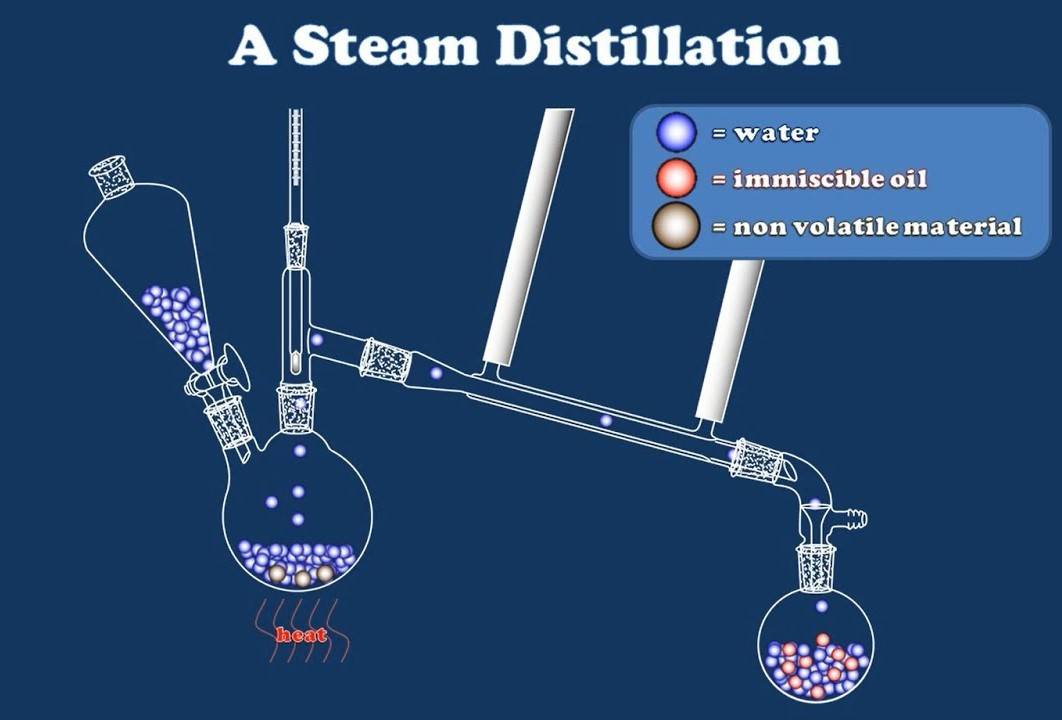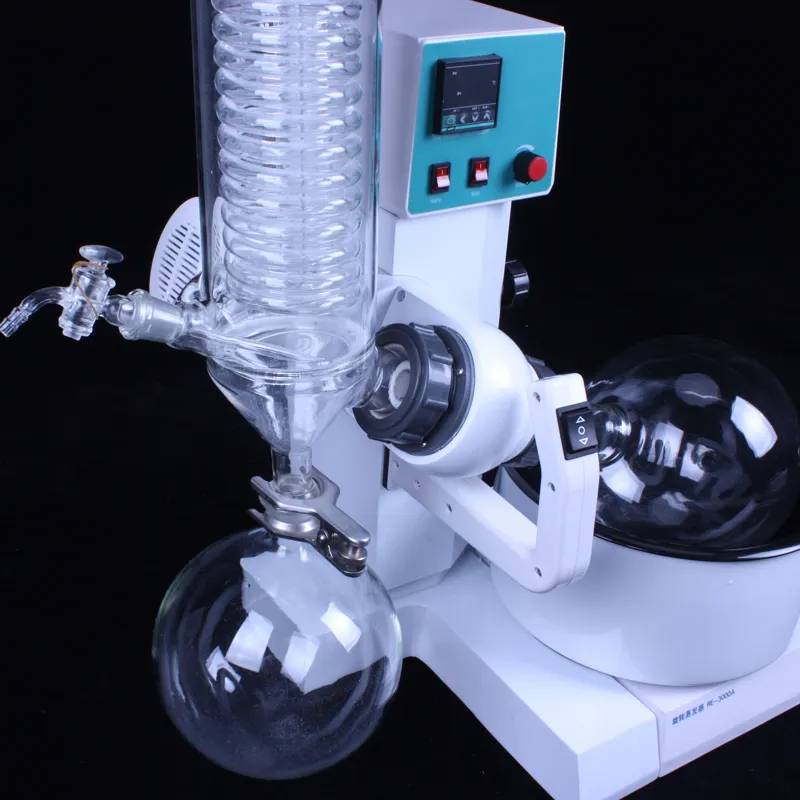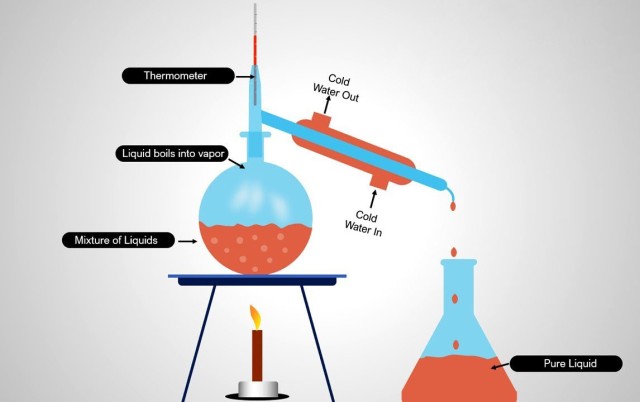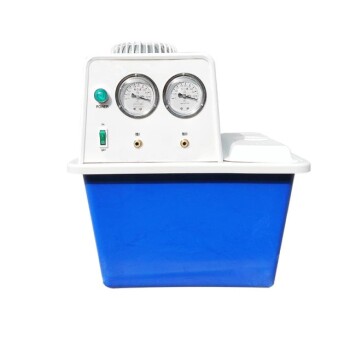Fundamentals of Rotary Evaporator Operation
Principles of Rotary Evaporator
Rotary evaporators are indispensable tools in the pharmaceutical, chemical, and biopharmaceutical industries, serving multiple purposes such as concentration, crystallization, drying, separation, and solvent recovery. These devices operate under controlled vacuum conditions, coupled with constant temperature heating, to facilitate efficient evaporation processes.
The core principle of a rotary evaporator lies in its ability to rotate the evaporation flask at a consistent speed, which creates a large surface area of thin film. This film formation significantly enhances the rate of evaporation by exposing more solvent to the vacuum and heat. The mechanical rotation of the flask not only increases the solvent's surface area but also mitigates the risk of "bumping," a phenomenon where a rapid formation of solvent vapor displaces the surrounding liquid.
Under vacuum, the boiling point of the solvent is reduced, allowing for evaporation at lower temperatures compared to atmospheric conditions. This characteristic is particularly advantageous for handling heat-sensitive compounds and solvents with low boiling points, such as ethyl acetate or n-hexane. For solvents with higher boiling points like water, the ability to withstand very low pressures becomes crucial, enabling their evaporation under controlled conditions.
The solvent vapor generated during the evaporation process is subsequently cooled and condensed by a glass condenser, which then collects the condensed solvent in a dedicated collection bottle. This recycling mechanism not only enhances the overall evaporation efficiency but also conserves the solvent for potential reuse.
In summary, the rotary evaporator's design and operational principles are meticulously engineered to optimize evaporation rates, ensure solvent recovery, and maintain the integrity of heat-sensitive compounds, making it a cornerstone in various industrial applications.
Importance of Distillation Efficiency
Distillation efficiency is pivotal in determining both work efficiency and the quality of the final product. A higher efficiency in distillation not only accelerates the process but also enhances the quality of the distillate, particularly for biochemical products that are sensitive to high temperatures. The speed at which distillation occurs plays a critical role in capturing minute flavor components, which are often present in trace amounts.
Fast distillation, when executed without causing saturation, results in a steady and constant flow of distillate within the condenser. This rapid condensation process is more effective at capturing these delicate flavor chemicals compared to slower distillation methods. In slow distillation, there is increased transit time within the condenser, providing more opportunities for these flavor components to escape into the vacuum system without condensing, thereby diminishing the overall quality of the distillate.
Moreover, the efficiency of distillation directly impacts the number of samples that can be processed per day. For industries dealing with temperature-sensitive biochemical products, the ability to distill more samples in a shorter time frame is not just advantageous but often essential for maintaining production schedules and product integrity.

Factors Affecting Distillation Efficiency
Cooling Medium Temperature
To ensure optimal distillation efficiency in rotary evaporators, the cooling medium must maintain a precise temperature differential from the heating pot. Specifically, a temperature difference of 40 °C is recommended. This substantial temperature gradient facilitates rapid condensation of the solvent vapor, which is crucial for maintaining system vacuum.
Rapid condensation minimizes the impact of steam on the system's vacuum, thereby stabilizing the distillation process. This temperature management is essential as it directly influences the rate at which the solvent vapor can be condensed and collected, enhancing the overall efficiency of the distillation process.
Moreover, maintaining this temperature difference helps in preventing fluctuations in the system vacuum, which can otherwise lead to inefficiencies and potential operational issues. By ensuring a consistent and rapid condensation process, the cooling medium plays a pivotal role in the successful and efficient operation of the rotary evaporator.
Heating Pot Temperature
Higher heating pot temperatures can significantly accelerate solvent distillation, thereby enhancing the efficiency of the rotary evaporator. This acceleration is particularly beneficial in industries such as pharmaceutical, chemical, and biopharmaceutical, where time is a critical factor. However, the operational safety and integrity of heat-sensitive components must be carefully balanced to prevent any detrimental effects.
Commonly, a temperature of 60 °C is used as a baseline for heating pot operations. This temperature is often considered a safe middle ground that allows for efficient distillation without compromising the integrity of heat-sensitive materials. To further optimize distillation speed, adjustments to the system vacuum are frequently made. By lowering the vacuum, the boiling point of the solvent is reduced, enabling faster evaporation at lower temperatures.
| Temperature (°C) | Vacuum (mmHg) | Distillation Speed | Safety Considerations |
|---|---|---|---|
| 60 | 600 | Moderate | Safe for most solvents |
| 70 | 500 | Faster | Requires monitoring |
| 80 | 400 | Fastest | Risk of thermal damage |
Adjusting the vacuum values in conjunction with the heating pot temperature can yield significant improvements in distillation efficiency. For instance, a lower vacuum of 400 mmHg at 80 °C can achieve the fastest distillation rates, but this setup necessitates close monitoring to ensure that heat-sensitive components are not adversely affected. Conversely, maintaining a higher vacuum of 600 mmHg at 60 °C provides a safer operational environment, albeit at a slightly reduced distillation speed.
In summary, while higher heating pot temperatures can expedite solvent distillation, it is essential to carefully manage both temperature and vacuum settings to achieve optimal efficiency without compromising safety or the integrity of heat-sensitive materials.

System Vacuum Value
The vacuum pump limit significantly influences the system vacuum, which in turn affects the overall efficiency of the distillation process. A lower vacuum pump limit results in a lower system vacuum, which can hinder the effectiveness of the rotary evaporator. To maintain optimal distillation efficiency, it is crucial to set a reasonable vacuum value using a vacuum controller. This ensures that the distillation process proceeds smoothly without causing the solvent to boil, which could compromise the quality of the final product.
Improving vacuum control can be achieved through several methods. One effective strategy is to install a vacuum controller, which allows for precise adjustments to the vacuum level. This device ensures that the system operates within the optimal vacuum range, enhancing distillation efficiency. Additionally, incorporating a vacuum valve can provide an extra layer of control, allowing operators to fine-tune the vacuum settings as needed.
| Vacuum Control Method | Advantages |
|---|---|
| Vacuum Controller | Precise adjustments, maintains optimal vacuum range |
| Vacuum Valve | Fine-tuning capabilities, additional control layer |
By implementing these enhancements, operators can achieve better vacuum control, leading to more efficient and reliable distillation processes.
Operational Considerations
System Vacuum Value
The system vacuum value plays a pivotal role in the operation of rotary evaporators, significantly influencing the efficiency of the distillation process. Proper management of this value is not just beneficial but essential for achieving optimal distillation outcomes.
A well-maintained vacuum value ensures that the solvent evaporation is controlled, preventing unnecessary boiling and enhancing the overall efficiency of the distillation process. This is particularly crucial in industries such as pharmaceutical, chemical, and biopharmaceutical, where the quality and purity of the end product are paramount.
To illustrate, consider the impact of a lower vacuum value on the system. When the vacuum is too low, it can lead to uncontrolled boiling, which not only hampers the distillation efficiency but also risks compromising the integrity of heat-sensitive components. Conversely, an appropriate vacuum value facilitates a steady and efficient evaporation process, ensuring that the solvent vapor is effectively condensed and recycled.
In practical terms, achieving the right vacuum value often involves the use of advanced control mechanisms such as vacuum controllers or vacuum valves. These tools allow for precise adjustments, ensuring that the system operates within the optimal vacuum range. For instance, a vacuum controller can automatically adjust the vacuum level based on real-time conditions, thereby maintaining a consistent and efficient distillation environment.
Moreover, the relationship between the system vacuum and the heating pot temperature is interdependent. A lower vacuum value typically requires a higher heating pot temperature to maintain the distillation rate, highlighting the need for a balanced approach. This balance is critical for both operational safety and the preservation of heat-sensitive materials.
In summary, the system vacuum value is a cornerstone of efficient rotary evaporator operation. Proper management and control of this value are essential for ensuring distillation efficiency, product quality, and operational safety.
Heating Pot Temperature
Maintaining an appropriate heating pot temperature is crucial for both distillation efficiency and operational safety. The heating pot temperature directly influences the rate at which solvents are distilled, which in turn affects the overall efficiency of the rotary evaporator. Higher temperatures can significantly accelerate the distillation process, but this must be balanced against the risk of damaging heat-sensitive components or causing safety hazards.
Temperature Guidelines
- Common Temperatures: Typically, heating pot temperatures are set around 60 °C. This temperature is generally effective for most solvents, ensuring a balance between distillation speed and safety.
- Adjustments for Efficiency: For faster distillation, the temperature can be slightly increased, but this should be accompanied by adjustments to the vacuum values. A lower vacuum can help maintain efficient distillation without causing the solvent to boil excessively.
Safety Considerations
- Heat-Sensitive Components: Some samples, particularly in the biochemical industry, are sensitive to high temperatures. Maintaining an appropriate heating pot temperature is essential to prevent degradation of these sensitive materials.
- Operational Safety: Excessive temperatures can lead to safety risks, such as overheating of the system or the risk of solvent boiling over. Proper temperature management is therefore critical to ensure safe operation.
Practical Tips
- Temperature Monitoring: Continuous monitoring of the heating pot temperature is recommended to ensure it remains within the optimal range. Modern rotary evaporators often come equipped with temperature sensors and controllers that can automate this process.
- Vacuum Adjustments: Pairing temperature adjustments with corresponding changes in vacuum settings can help maintain efficient distillation while ensuring safety. For instance, increasing the temperature slightly can be balanced by lowering the vacuum to prevent boiling.
By carefully managing the heating pot temperature, users can significantly enhance the efficiency of their rotary evaporator while ensuring safe and reliable operation.
Rotation Speed of Evaporation Flask

The rotation speed of the evaporation flask is a critical parameter that significantly affects the formation of the film and the overall efficiency of the evaporation process. When the flask rotates, it performs two primary functions: it agitates the water bath liquid, facilitating better heat transfer to the flask and the solvent, and it increases the surface area of the liquid inside the flask, thereby enhancing the evaporation rate.
While a faster rotation speed generally improves evaporation efficiency, there is an optimal range beyond which the benefits diminish. At higher speeds, the turbulence of the liquid can decrease as the sample is pressed against the sides of the flask, potentially reducing evaporation efficiency. Additionally, excessive speed can lead to premature wear on the equipment, necessitating careful monitoring and adjustment.
For most benchtop-scale rotary evaporators, a rotation speed of 250–280 rpm is recommended to achieve maximum turbulence. However, this range can vary based on several factors, including the type of solvent and sample consistency, the size of the flask, and the fill level. For instance, larger evaporating flasks typically require medium to low speeds, while solutions with high viscosity may necessitate even lower speeds to prevent unnecessary wear and maintain optimal efficiency.
To ensure the best performance, it is advisable to start the machine at the minimum speed and gradually increase it to the desired level. This approach not only helps in preserving the equipment but also allows for fine-tuning the rotation speed to match the specific requirements of the distillation process.
Related Products
- Laboratory Benchtop Water Circulating Vacuum Pump for Lab Use
- Vacuum Sealed Continuous Working Rotary Tube Furnace Rotating Tube Furnace
Related Articles
- How to Choose and Optimize Water Circulating Vacuum Pumps for Your Lab
- Step-by-Step Guide to Operating a Short Path Distillation Apparatus
- Exploring the Science Behind Rotary Evaporators: How They Work and Their Applications
- How to Choose Laboratory Vacuum Pumps for Maximum Efficiency and Cost Savings
- Choosing the Right Rotary Vacuum Evaporator for Your Lab


